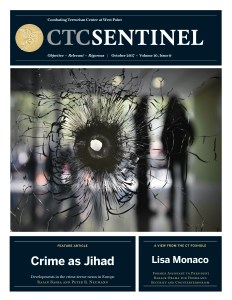From the Editor
In our October cover article, Rajan Basra and Peter Neumman explore the strong nexus between crime and jihadism in Europe. With a significant proportion of European foreign fighters having criminal backgrounds, they outline how the Islamic State is going out of its way to depict crime as helpful to its cause and to recruit criminals for terrorist enterprises. Our interview this month is with Lisa Monaco, President Obama’s chief counterterrorism advisor during his second term.
In July, police in Sydney, Australia, discovered alleged plots by two brothers to detonate a bomb on a passenger jet and release poison gas on a target such as public transportation. Andrew Zammit outlines why it set off alarm bells in counterterrorism agencies worldwide. An Islamic State cybercoach in Syria allegedly arranged for a partially constructed bomb with military-grade explosives to be air-mailed to the plotters from Turkey and provided sufficient instructions for them to build a fully functioning device. This ‘IKEA-style’ approach to terrorism could be a game-changer because untrained Western extremists have hitherto found it difficult to make high explosives. The Islamic State cybercoach also transmitted know-how on making a poison gas dispersal device to the Australian cell.
Columb Strack looks at the evolution of the Islamic State’s chemical weapons efforts in Syria and Iraq and the possibility that the group could export chemical terror to the West. John Mueller examines the degree to which the cybercoaching of terrorists should be cause for concern, arguing that in many cases cybercoaches have little control over their amateurish charges.
Finally, Derek Flood, recently back from the frontlines, outlines how the capture of Hawija, the Islamic State’s last remaining urban stronghold in northern Iraq, exposed faultlines between Baghdad and Erbil, which set the stage for the dramatic events unfolding in the Kirkuk area.
Paul Cruickshank, Editor in Chief
 Skip to content
Skip to content

